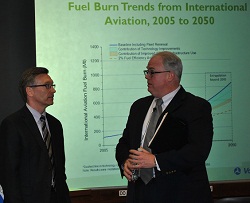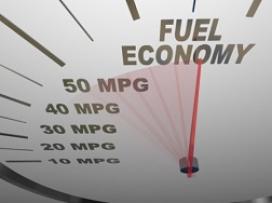Progress in Reducing CO2 Emissions: Is It Enough?
Transportation is a major contributor to greenhouse gas emissions and climate change. Volpe’s Gregg Fleming, director of Policy, Planning, and Environment, recently delivered a talk about the ongoing U.S. initiatives to reduce transportation climate impacts. This talk was part of Volpe’s speaker series Transportation System Resilience, Extreme Weather, and Climate Change.
Fleming discussed President Obama’s Climate Action Plan, stating that it includes a framework for measuring progress in cutting carbon pollution. He provided an overview of the plan, which includes the following key elements:
- Deploying clean energy
- Reducing greenhouse gas emissions
- Building a 21st-century transportation sector
- Cutting energy waste
- Leading at the federal and international levels
 Providing fresh data about climate change and carbon pollution, Fleming said that fuel cells are projected by industry to be the fastest growing source of energy for passenger vehicles in the next several decades. Biofuels are projected to grow in significance, primarily for aviation and maritime.
Providing fresh data about climate change and carbon pollution, Fleming said that fuel cells are projected by industry to be the fastest growing source of energy for passenger vehicles in the next several decades. Biofuels are projected to grow in significance, primarily for aviation and maritime.
Fleming showed data about CO2 in the atmosphere to help the audience understand why CO2 garners so much focus in climate change discussions.
“If you release a pulse of CO2 into the atmosphere, 300 years down the road, about 20 percent [of that pulse] is still in the atmosphere," he said. "Ten thousand years down the road, about 10 percent is still in the atmosphere. So even if we turned off the spigot today, we'd still have all this CO2 that's built up.”
Examining the global energy forecast, Fleming cited data from ExxonMobil projecting that 62 percent of the global growth in energy use over the next 20 years will come from the Asian Pacific region. The U.S. and Europe are not projected to increase their total energy use in this time period.
With respect to emissions from passenger vehicles, Fleming provided an overview of Volpe’s involvement in the development of Corporate Average Fuel Economy (CAFE) standards and the savings these standards have enabled: 14 billion tons of CO2 emissions since the 1970s.
An international expert in global aviation emissions, Fleming explained that the International Civil Aviation Organization (ICAO) has set a fuel efficiency goal for international aviation of 2 percent per annum. Fleming, who represents the Federal Aviation Administration at ICAO meetings, described progress toward achieving this goal through technological improvements such as the FAA CLEEN program, and operational improvements, such as FAA’s NextGen and the European Union’s SESAR. In the best case scenario, international aviation is projecting 1.4 percent per annum fuel efficiency in the long term.
“Getting to that 2 percent fuel efficiency goal is going to be quite a challenge,” he said.
A second ICAO goal for international aviation is achieving carbon-neutral growth relative to a 2020 baseline, which also poses some significant challenges. Alternative fuels will provide some contribution to carbon-neutral growth, but there is still substantial uncertainty as to how much, and there will likely still be a gap.
To address this gap, ICAO is studying global market-based measures (MBM). The airline industry is supportive. Fleming indicated that ICAO agreed to have an MBM framework in the 2016 timeframe with a goal for implementation around 2020.
View Fleming’s research.

